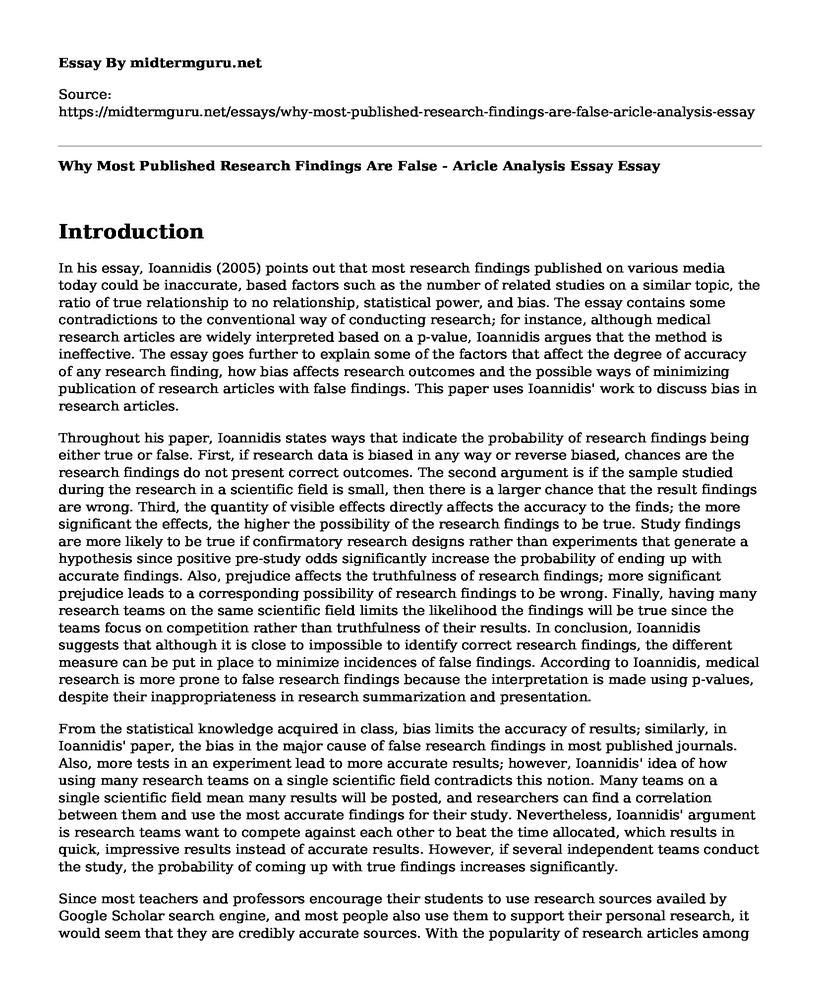Introduction
In his essay, Ioannidis (2005) points out that most research findings published on various media today could be inaccurate, based factors such as the number of related studies on a similar topic, the ratio of true relationship to no relationship, statistical power, and bias. The essay contains some contradictions to the conventional way of conducting research; for instance, although medical research articles are widely interpreted based on a p-value, Ioannidis argues that the method is ineffective. The essay goes further to explain some of the factors that affect the degree of accuracy of any research finding, how bias affects research outcomes and the possible ways of minimizing publication of research articles with false findings. This paper uses Ioannidis' work to discuss bias in research articles.
Throughout his paper, Ioannidis states ways that indicate the probability of research findings being either true or false. First, if research data is biased in any way or reverse biased, chances are the research findings do not present correct outcomes. The second argument is if the sample studied during the research in a scientific field is small, then there is a larger chance that the result findings are wrong. Third, the quantity of visible effects directly affects the accuracy to the finds; the more significant the effects, the higher the possibility of the research findings to be true. Study findings are more likely to be true if confirmatory research designs rather than experiments that generate a hypothesis since positive pre-study odds significantly increase the probability of ending up with accurate findings. Also, prejudice affects the truthfulness of research findings; more significant prejudice leads to a corresponding possibility of research findings to be wrong. Finally, having many research teams on the same scientific field limits the likelihood the findings will be true since the teams focus on competition rather than truthfulness of their results. In conclusion, Ioannidis suggests that although it is close to impossible to identify correct research findings, the different measure can be put in place to minimize incidences of false findings. According to Ioannidis, medical research is more prone to false research findings because the interpretation is made using p-values, despite their inappropriateness in research summarization and presentation.
From the statistical knowledge acquired in class, bias limits the accuracy of results; similarly, in Ioannidis' paper, the bias in the major cause of false research findings in most published journals. Also, more tests in an experiment lead to more accurate results; however, Ioannidis' idea of how using many research teams on a single scientific field contradicts this notion. Many teams on a single scientific field mean many results will be posted, and researchers can find a correlation between them and use the most accurate findings for their study. Nevertheless, Ioannidis' argument is research teams want to compete against each other to beat the time allocated, which results in quick, impressive results instead of accurate results. However, if several independent teams conduct the study, the probability of coming up with true findings increases significantly.
Since most teachers and professors encourage their students to use research sources availed by Google Scholar search engine, and most people also use them to support their personal research, it would seem that they are credibly accurate sources. With the popularity of research articles among students, I had not come across anyone citing any research to contain wrong information. However, Ioannidis' essay has proved beyond a reasonable doubt, that some published research journals may indeed hold false information. Before choosing a specific published research paper to use for personal studies or further research, I believe it is essential to compare related papers, and at times search for the respective journal critique articles to identify how well they deliver essential information and what others think of them.
Ioannidis suggests that although it is impossible to know whether there is 100% certainty in a research question, incidences of false findings in research findings can be minimized in several ways. First, greater power evident should be provided since large scale evidence minimizes the risk of bias in a research paper; this can be achieved through more extensive studies. Also, large scale evidence should be used in studies with higher pre-study probability, to achieve more stable and high post-study probability. However, large-scale evidence is mostly presented in cases of huge concepts, instead of concentrating on a specific question; therefore, an adverse finding can affect the better part of the research field, if not the whole of it. The second way of minimizing the chances of ending up with inaccurate research findings is minimizing the number of research teams working on a study because majoring on the facts presented by any single team can be misleading. Although this method minimizes bias, it goes against the traditional scientific approach to research; therefore, Ioannidis recommends a change in the scientific mindset on research. The third and final method suggested is, before research, scientists should approach cases that they believe have higher chances of being authentic instead of non-true relationship since confirmatory tests have minimal bias.
References
Ioannidis, J. P. (2005). Why Most Published Research Findings Are False. PLoS Medicine, 2(8), e124. doi:10.1371/journal.pmed.0020124
Cite this page
Why Most Published Research Findings Are False - Aricle Analysis Essay. (2023, Jan 10). Retrieved from https://midtermguru.com/essays/why-most-published-research-findings-are-false-aricle-analysis-essay
If you are the original author of this essay and no longer wish to have it published on the midtermguru.com website, please click below to request its removal:
- Answers to Questions on MDA Treatment and Skin Diseases
- Patient Safety and Quality Improvement - Paper Example
- Essay Example on Holistic Nursing
- Approach to Cancer Care - Paper Example
- Japanese Maternity Culture - Essay Sample
- Oscar's Journey With Hemophilia Type A: A Genetics Story - Research Paper
- Nutrition Assessment: Determining Nutrient Extent for Optimal Health - Essay Sample







